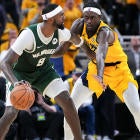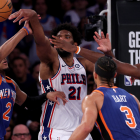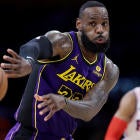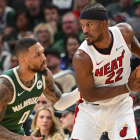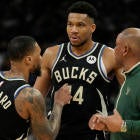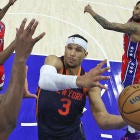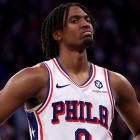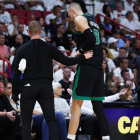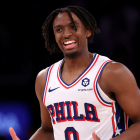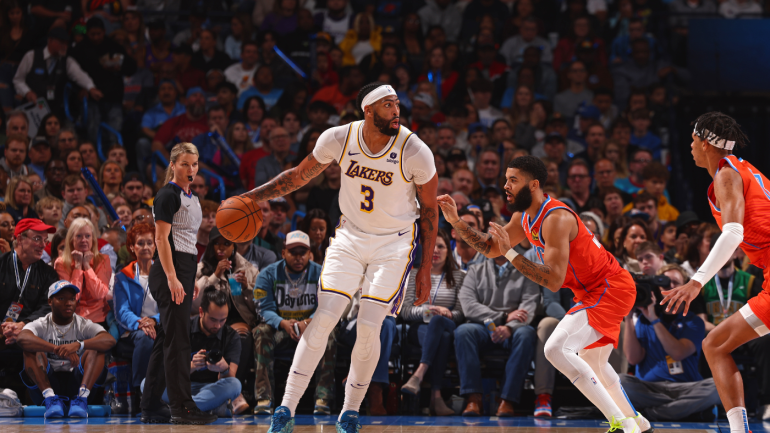
Darvin Ham tried to resist changing his starting lineup throughout the recent four-game losing streak the Los Angeles Lakers endured. "You can't just keep, on a whim, changing," Ham said after Wednesday's loss to the Chicago Bulls. "That's a big deal when you change your starting lineup at this level." But after Thursday's loss to the Minnesota Timberwolves, Ham relented. Change was necessary. He just didn't take it in the direction most fans expected.
Would he sub Austin Reaves in for the struggling D'Angelo Russell? Perhaps he'd bring back the starting lineup that took the Lakers to the Western Conference Finals a year ago, the one that featured both Reaves and Russell alongside LeBron James, Anthony Davis and Jarred Vanderbilt, who recently returned after a lengthy absence. In the end, neither Russell nor Reaves, both of whom opened the season as starters, were part of the new lineup. Vanderbilt, a non-shooter, joined James, Davis, Taurean Prince and Cam Reddish in the new-look starting five on Saturday.
The on-court results were slightly more positive than negative in the first go-round. In around nine minutes of play, that lineup outscored Oklahoma City by one point. The Lakers, who have fallen behind in first quarters all season, held their own early on. Ultimately, the Lakers managed to win the game, 129-120, and the principal figures were largely upbeat. Ham praised the group's "size and physicality" as a means of enabling switch-ability on defense. Russell, who came off of the bench for the first time in the regular season since the 2020-21 campaign, acted comfortable with his new role. "The result was a win," Russell said. "To me, that's all that matters."
But in the grand scheme of things, the lineup's flaws could prove problematic for a coach who has openly expressed reluctance to make further changes. The obvious weakness is spacing. James operated as the lineup's point guard, and the Lakers leaned on the James-Davis pick-and-roll more than ever. In itself, that isn't a problem. That was the offensive formula when the Lakers won the championship in 2020. But that group had plenty of shooters.
This lineup is almost comically devoid of shooting by 2023 standards. The trio of Prince, Reddish and Vanderbilt have averaged only 3.24 combined 3-point attempts per game across their careers. Prince, though up-and-down this season, has shot fairly well. Reddish and Vanderbilt rarely get guarded. That creates even more traffic at the rim for James and Davis. They maneuvered through it very well on Saturday. Still, they won't always be able to. The goal here should be to make life easier for James, not harder.
Space does that. So does extra ball-handling. There's a reason James pushed for the disastrous Russell Westbrook acquisition, after all. His preference is to play forward, not point guard at this stage of his career. The Lakers had two extra ball-handlers in the starting five during their playoff run a season ago in Reaves and Russell. They had none on Saturday. James can handle the load for a game, and he can likely swing it for a month. Asking him to do it for a whole season is unreasonable. He turns 39 before the end of December.
When Reaves was benched in November, part of the logic was to separate him and Russell as much as possible for defensive purposes. If both of them are sitting out the first few minutes of each half, doing so becomes substantially harder without seriously cutting into their minutes. Sure enough, Reaves played 28 minutes and Russell played 17. They combined to average 60.6 after last season's trade deadline. An offense that currently ranks 24th probably can't afford to play its secondary and tertiary ball-handler so little.
The theoretical benefit to doing so is defensive improvement. The results on that end of the floor were mixed. Oklahoma City scored 23 points in the nine minutes or so it faced that lineup, and that number could have been bigger had the Thunder made more of the wide-open 3's the Lakers gave them.
In lineup building, balance is critical. That was part of what made last year's starting group so strong. Russell is a defensive liability. Vanderbilt is an offensive liability. But so long as James, Davis and Reaves held up their end of the bargain on both ends, the Lakers could take advantage of all five of them. That group outscored by opponents by 20.6 points per 100 possessions in the regular season.
In the longer term, there might be a method to Ham's madness. Reaves has taken to his bench role well. Russell has struggled lately. Perhaps the Lakers sense a trade is coming and want to cycle Russell out of the starting lineup before his replacement arrives without disturbing Reaves. It's hard to imagine the Lakers taking such a flawed offensive lineup into the postseason.
But the Lakers are only 16-14. Even if a trade that supplies the starting lineup with a new secondary ball-handler like Chicago's Zach LaVine does come, the Lakers can't afford to drop games waiting for it. The Lakers and 11th-seeded Suns are tied in the loss column. They're taking a significant risk by playing a lineup with so little shooting, and given Ham's hesitance to make changes, they're at risk of falling even further down the standings while this experiment plays out.














